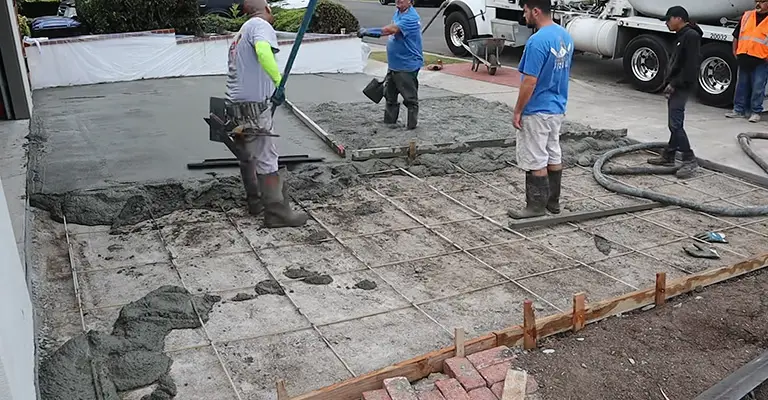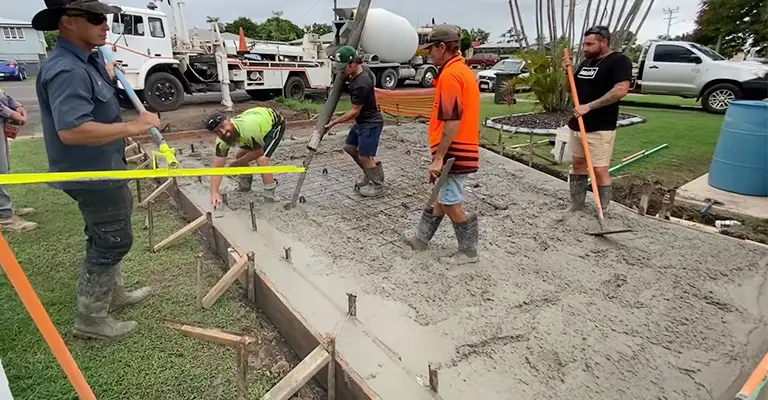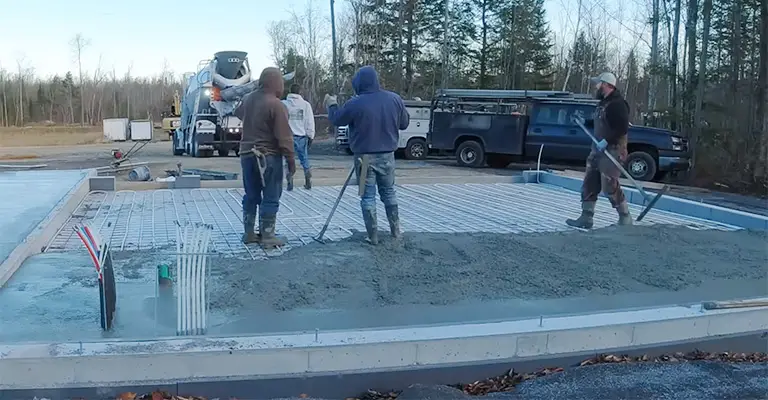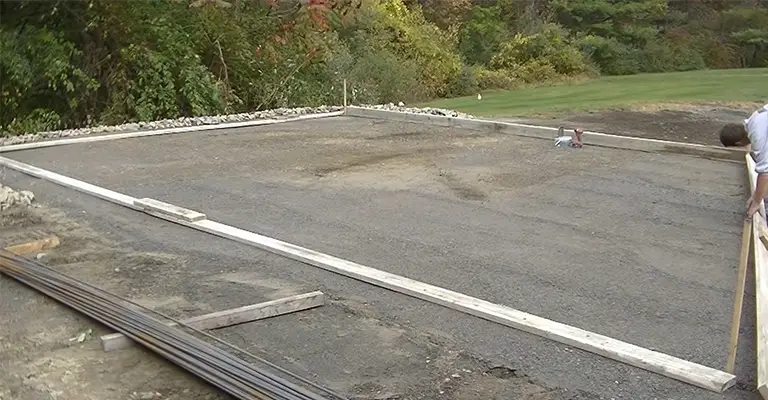Concrete, a fundamental building material, holds the key to creating structures that stand the test of time. A crucial phase in its development is the curing process, where it gains strength and durability over time.
But what happens when concrete is allowed to cure beneath a blanket of soil?
Concrete can cure under dirt. In fact, curing concrete in a moist environment, like being covered by soil, is often beneficial for its strength and durability.
The curing process involves maintaining adequate moisture and temperature levels to allow the concrete to achieve its desired strength and durability properties.
Burying the concrete as soon as possible is a good idea if the soil is moist. To ensure maximum strength, it is important to allow concrete to cure slowly.
Concrete becomes weak when it is dried before it has fully cured. The best way to keep it moist is to keep it for at least a week. There is no need to wait for a year.
What Happens To Concrete If It Gets Buried Before It Fully Dries?
Concrete never dries out, it hydrates. Hardening occurs as a result of a chemical reaction with water.
Water chemically combines with cement in concrete to give it strength. It will cease to grow if it is deprived of water by drying.
It is possible for the soil to absorb moisture from the concrete if it is dry. Nonetheless, it should be realized that civil contractors routinely bore and fill pier holes.
Compaction of soil before the concrete has reached a reasonable strength should avoid damaging the concrete by damaging the soil.
The dirt will help the concrete cure more slowly by keeping moisture in it. Due to the evaporation of the water, the concrete will become stronger than concrete exposed to air.
How Long Does It Take Concrete to Cure Completely?

There is no such thing as a fully cured concrete. Every day, it hardens a little bit more. It is due to the reaction between cement particles and water that concrete hardens.
Concrete becomes harder as the cement bonds with the water molecules. Even after achieving “full strength,” there will always be tiny moisture bubbles in your concrete, so it will continue to get slightly harder.
It’s really about how long does concrete take to set enough for whatever purpose you have in mind. How long before you can drive or park on it without sinking into it, or walk on it without leaving footprints?
In order to keep the water in concrete, curing agents are often sprayed on it. Concrete is hardened and strengthened through hydration, a chemical reaction. Water is necessary for the hydration process.
How Long Does It Take For Concrete To Cure Under Ground?

It won’t take long for your concrete to be ready. It should take anywhere from 24 to 48 hours for your concrete to be solid enough for walking on, without leaving footprints.
It is recommended that you cure your concrete to 70% strength within seven days. The road should be safe to drive on, but heavy equipment may need to be avoided. Your concrete will be fully hardened in 28 days.
What Is Curing?
The visual effects of curing may be visible on the surface of concrete, but the concrete’s core also undergoes changes in the curing process.
Driveways, sidewalks, foundations, and other surfaces are constructed from this hard, resistant surface.
The process of curing is different from the process of drying. It is during and after the curing of concrete that it reaches the specific properties needed for its intended applications.
Curing gives concrete its physical properties, while drying helps it achieve those properties. Concrete can be cured in many ways, but water curing and membrane curing are the most common:
- Concrete is coated with a liquid membrane that solidifies into a water-based or oil-based membrane layer to prevent evaporation.
- To maintain continuous moisture levels in concrete, pouring, sprinklers, ponding, or immersion are used as methods of water curing.
What Are Some of the Factors That Affect How Long Concrete Takes to Dry?

What is the drying time of concrete under different conditions? Different situations require different drying times for concrete.
Concrete cure times can be affected by several factors. Here are a few of them:
Mix Design
There are some concrete mixtures that cure faster than others. In contrast to traditional concrete formulas, these “quick-drying” formulas require specific mixing and pouring techniques to ensure strength and stability.
If you add accelerants to concrete mixtures before curing, it may work for small applications, but don’t expect the final product to last for as long.
Temperature
For concrete curing, it is usually ideal to have a hot temperature, as it helps moisture evaporate more quickly.
Even so, it’s not safe to work in excessively high temperatures, especially if you’re pouring large areas of concrete at once. Moisture may also be disrupted by too much humidity.
The cold is less tolerant of concrete pouring techniques – if the temperature is below 4 degrees Celsius, or 40 degrees Fahrenheit, special techniques must be used.
Concrete shouldn’t be poured below -6 degrees Celsius or 20 degrees Fahrenheit.
Even though cold spells aren’t always predictable, it’s ideal to plan your concrete projects around warmer seasons and temperatures.
Uncured concrete should be kept safe from the cold for at least a few days, if not longer, if you’re working in the spring or fall.
Moisture
Hardening and curing are facilitated by water. A concrete’s strength comes from its hard crystals, which are formed by chemical reactions.
Concrete with too little water becomes structurally weak, while concrete with too much water will fail to cure properly and flake, shrink, divot or crack.
When there is a likelihood of rain or storms, it’s best to avoid pouring concrete – water channels and puddling can damage uncured concrete, creating an imbalance in moisture levels that can be irreversible.
You should be fine if your concrete has cured for at least six to eight hours before a quick rainstorm – but younger mixtures or heavier, prolonged rain could cause problems.
When concrete is still curing, you shouldn’t apply anything to it – paints and stains can also interfere with the chemical process and moisture content.
Will Concrete Cure in Cold Weather?
Unlike concrete that simply dries out, concrete cures chemically. A variety of environmental factors can affect concrete curing, such as moisture or air temperature. Is concrete affected by cold weather?
The process of curing concrete in cold weather can be assisted by taking specific steps. A concrete cure will not be effective below 40 degrees Fahrenheit (4 degrees Celsius) without certain precautions.
This process will ensure that the concrete settles properly and that the slab will not be weakened if you do not follow these steps. Temperatures between 40°F and 60°F (4°C and 15°C) are ideal for curing concrete.
Will Concrete Cure Without Air?
There are many uses for concrete in construction, including homes, sheds, and even industrial properties. Most people are unaware of what concrete needs to cure and dry, despite it being everywhere.
Can concrete cure without air near the slab? It is possible to cure concrete without air. Air curing of concrete is not very effective.
Curing concrete with air exposure can increase its durability by 50% compared to concrete cured in water or with any other material. As a result, concrete cures better without air.
Concrete does not require oxygen to set. In the process of curing, concrete releases water and moisture, forming a long-lasting concrete slab.
It is common for concrete slabs to be buried underground or submerged in water during the curing process.
If this happens, you can seal the concrete to prevent it from being exposed to the air. As a result, the concrete forms a strong bond and cures excellently.
Will Concrete Cure Underwater?
In order for concrete to cure, certain conditions must be present. Your new concrete piece may not harden properly if you don’t control and optimize the requirements.
Concrete may become weakened if the curing process is ineffective. When concrete is submerged, will it have enough time to cure?
It is possible for concrete to cure underwater. In order for concrete to solidify, it must be sprayed with water during curing.
Submerging concrete completely underwater may not harden all varieties of concrete. Underwater, Portland cement-containing concrete can cure.
Portland cement is a type of cement that cures underwater. Because of this, you must use the right cement when pouring concrete underwater.
Using a frame around a concrete slab that holds a layer of water above the slab as it cures, some contractors use a technique for curing concrete underwater. Concrete is cured and set more effectively using this technique.
Final Words
Construction and flooring materials made of concrete are durable and long-lasting. Sand, cement, and water make up concrete. Avoid losing resistance, durability, and strength by letting it settle and solidify.
In order for concrete to cure and set underneath dirt, it needs a stable and even surface on which to pour it. Make sure the ground is leveled and maintained by packing down the dirt and soil.








